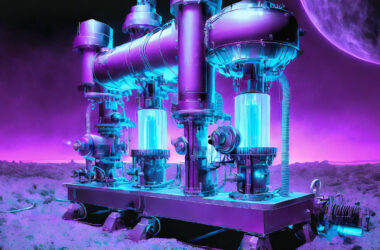The Mars City Design Architecture prize aims to take seriously the question of how people live on Mars. This year the international competition was won by “Redwood Forest” – a novel design from a team at MIT.

The team award winning ‘Redwood Forest’ would create dome and tree habitats which can each hold 50 people.
The idea is simple – domes would provide open, public spaces containing plants and water (taken from the northern plains of Mars) while trees would sit on top of a network of underground tunnels. With their ‘roots’ proving private spaces and easy transportation to other tree habitats.

The team believe such a design could allow for communities of up to 10,000 people to exist on Mars whist providing a simple solution to problems like cosmic radiation, micrometeorite impacts, and extreme thermal variations.
On Mars, our city will physically and functionally mimic a forest, using local Martian resources such as ice and water, regolith (or soil), and sun to support life. Designing a forest also symbolizes the potential for outward growth as nature spreads across the Martian landscape. Each tree habitat incorporates a branching structural system and an inflated membrane enclosure, anchored by tunneling roots. The design of a habitat can be generated using a computational form-finding and structural optimization workflow developed by the team. The design workflow is parametric, which means that each habitat is unique and contributes to a diverse forest of urban spaces.Sumini and Assistant Professor Caitlin Mueller – leader of the interdisciplinary team
The team was made up of people from different departments at MIT and included 9 students. George Lordos – who works out of the Department of Aeronautics and Astronautics – explained that “Every tree habitat in Redwood Forest will collect energy from the sun and use it to process and transport the water throughout the tree, and every tree is designed as a water-rich environment,” says Lordos. “Water fills the soft cells inside the dome providing protection from radiation, helps manage heat loads, and supplies hydroponic farms for growing fish and greens. Solar panels produce energy to split the stored water for the production of rocket fuel, oxygen, and for charging hydrogen fuel cells, which are necessary to power long-range vehicles as well as provide backup energy storage in case of dust storms”.
While a colony on Mars might still be several decades off the technology used could also be utilized on Earth
In particular the use of all electric vehicles traveling underground could ease congestion; and tree habitats could allow people to live in harsh enviroments like the sea-floor or deserts.

The MIT team included AeroAstro PhD students Samuel Wald, Matthew Moraguez, and Alejandro Trujillo; architecture PhD student Alpha Arsano SM ’17 and research fellow Kam-Ming Mark Tam MEng ’15; integrated design and management program graduate students Meghan Maupin and John Stillman; and civil and environmental engineering undergraduate student Zoe Lallas.







